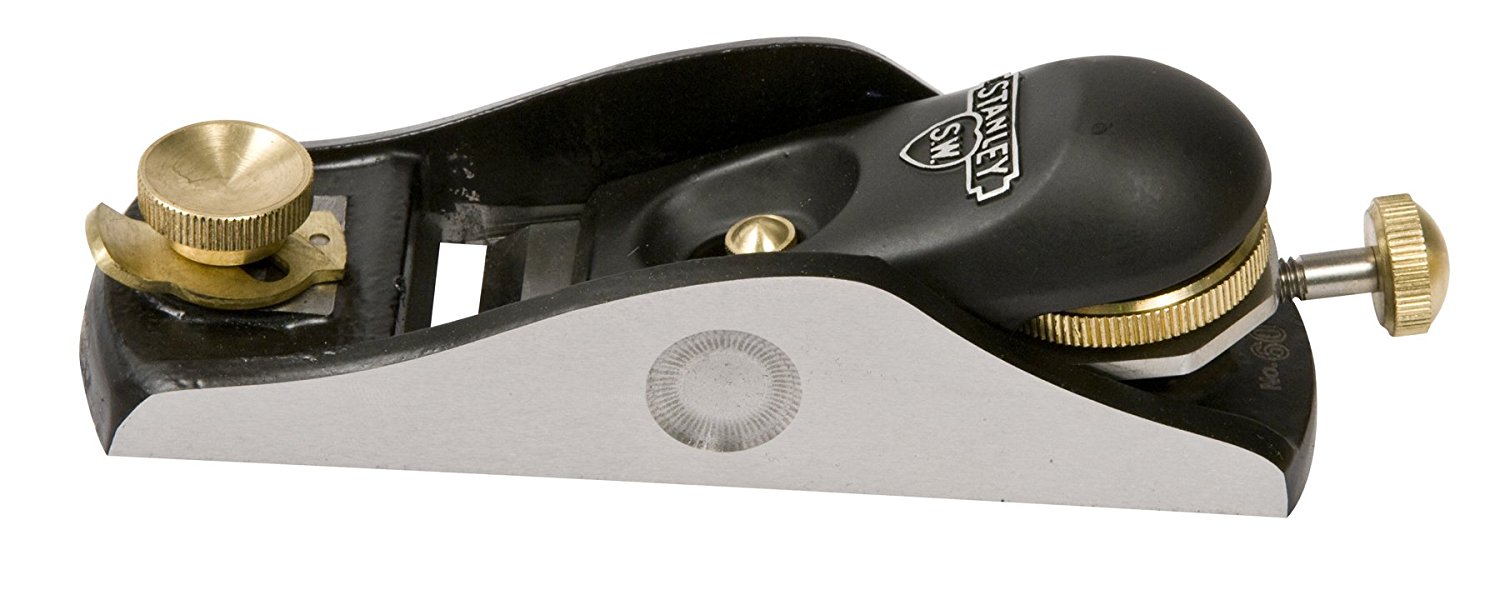If you’re in the market for a low angle block plane, it’s important to frame your expectations according to your trade. Timber Framers have very different needs than cabinetmakers. Considerations about precision and even price should be based on workplace and usage. It doesn’t make sense to spend a small fortune on a tool that will get tossed around. And, fine craftsmen absolutely will not find a serious block plane at a bargain-basement price. The general rule here is that you get what you pay for.
Lie-Nielson 
| Stanley 12-139 
| Stanley 12-960 
| Veritas 
| |
|---|---|---|---|---|
Bed Angle | 12-20 Degrees | n/a | 13.5-21 degrees | n/a |
Body Material | Bronze Cap | Cast Iron | Cast Iron | Cast Iron |
Stanley 12-139 Bailey No.60-1/2 Low Angle Block Plane
Stanley has a respectable reputation in the tool-making industry and this No. 60 ½ hand plane represents a foray into premium planes. It attempts to harken back to the quality tools of yesteryear and incorporates the SW (Sweetheart) logo as a reference to 1930s era craftsmanship.
The cast iron base runs 2 1/8 inches wide and 6 ½ long and enjoys a one-piece frog and base design to reduce chatter. The adjustment mouth has an eye toward tear-out reduction and the tool can produce very fine shavings. The adjustment hardware is solid brass.
Stanley Hand Tools is a nostalgic brand for old framers. It began in the mid-1800s as a New England staple, but merging with Black & Decker in recent years hasn’t exactly upgraded the manufacturer into the high-end tool big leagues. To say this block plane pales in comparison to the Lie-Nielsen would be an understatement. Users give the hand tool high marks but one negative is that the aluminum lever cap has questionable durability.
Stanley 12-960 Contractor Grade Low Angle Plane
This Stanley contractor-grade hand planer fares better than the “Sweetheart” in the overall users reviews but it’s far from a true craftsman’s tool. Slightly smaller at 6 inches, it handles a 1 3/8-inch shave and is fashioned from gray cast iron with sleek, refined sides and base. The cam-lock release makes iron removal convenient. Cutting angles range from 21 to 13 ½ degrees and the tool has a durable epoxy coating.
Users also give this Stanley low marks and it requires unexpected adjustments when in play. On the plus side, it’s meant for framer doing less refined work and some users were fine with that after touching up the tool. Basically, it’s not a high-end, premium tool and doesn’t pretend to be one. The truly negative reviews tend to come from craftsmen who may have seen this planer as a bargain based on Stanley’s yesteryear reputation. If you’re working on site this tool can make a reasonable companion.
Lie-Nielsen Low-Angle Adjustable-Mouth Block Plane 60-1/2
If you’re in the market for a high-end block plane, Lie-Nielsen is a brand that has an exceptional reputation. Based in Maine, the family-owned company has been manufacturing high quality woodworking tools since 1981. Their tools have an eye toward traditional designs and hand planes are their claim-to-fame. This tool is no exception.
The 60-1/2 features a large bronze cap iron that fits your hand like a velvet glove. Its adjustable throat manages rough wood or fine shavings on finish work. The bed angle runs from 12-20 degrees and the 6 1/4 -inch body features 1 3/8-inch irons. It even comes with an optional leather holster.
The level of precision tool-making excellence is abundantly clear when you pick up this Lie-Nielsen. It’s not just a tremendous hand tool, it’s also quite beautiful. Although it trends on the smaller side of this class of tools, the perfectly-sized bronze cap and sleek body put this plane among the most comfortable to handle. When doing refined hand labor, that comfort translates into good finished work.
In terms of manipulating the blades, the good-sized adjustment nut is easy to manage and you use a small hammer to set the 1/8-inch iron laterally. That’s by design, not happenstance. The throatplate excels at taking fine shavings.
Users give the Lie-Nielsen nothing but overwhelming praise and perfect five-star ratings. It’s as if they are on a perpetual honeymoon that will last beyond their lifetime. Without question, this Lie-Nielsen block plane stands at the top of the class. It’s more than just an outstanding hand tool, it will be passed down from generation to generations of woodworkers.
Veritas Low-Angle Block Planes

In Roman mythology, Veritas was the goddess of truth. In tool-making, Veritas is eye-catching and won’t lie to you. Lee Valley is a family-owned company founded in the late 1970s and hails from Ottawa, Canada. It made the jump to its own tool line in 1982 and Veritas is its manufacturing arm. The brand specializes in precision hand tools and power tool accessories.
Like the Lie-Nielsen, Veritas planes are a thing of beauty. This low-angle features tall winged sides with finger grips that improve control. Its two-guide screw system stops blade shift and the finely polished cast iron body is durable and ground to a fine finish. Everything about the tool’s design, handling and precise capabilities is godly. The low-angle plane’s blade advance and lateral adjustments are among the best on the market today.
Pro users give Veritas planes extraordinarily high marks. The hand tool comes ready to work and demonstrates the precision timber framers demand. It sweeps through hardwoods effortlessly and, like Lie-Nielsen, outpaces the rest of the class. Simply put, Veritas planes are the gospel truth.
Please note:
Timber Frame HQ is a participant in the Amazon Services LLC Associates Program, an affiliate advertising program designed to provide a means for us to earn advertising fees by advertising and linking to amazon.com. When you purchase something from Amazon, a small percentage of the sale goes to support the efforts of TFHQ.
The Stanley Contractor model, at 1/6 the price, with a properly sharpened and set blade does just as well.
If the tool is sound, the sole is flat and the blade sets properly the only thing touching the wood to be cut is the blade edge and the sole of the plane.
I agree they are a great tool and all one needs.
I could not agree MORE!
I have a recent Stanley low angle block plane. Even with a good sharp blade it does not compare well to the ancient Stanley block plane I had as a kid. Unfortunately I no longer have that plane. I also have a couple of Veritas planes, the jack plane and the 3/4″ shoulder plane. They are far superior to the Stanley, the adjustments are easy and stay in place and the blade is better steel, and there is no chatter. I’m not sure a price 6 times as high is warranted, but they are very nice.
Thanks for your thoughts, Peter. I would agree with your assessment. You can buy an after-market blade for the Stanley that makes a big difference and put it on par with the older one. You can find them at https://www.leevalley.com/en-us/shop/tools/hand-tools/planes/blades/102812-stanley-block-plane-blades-made-by-veritas.